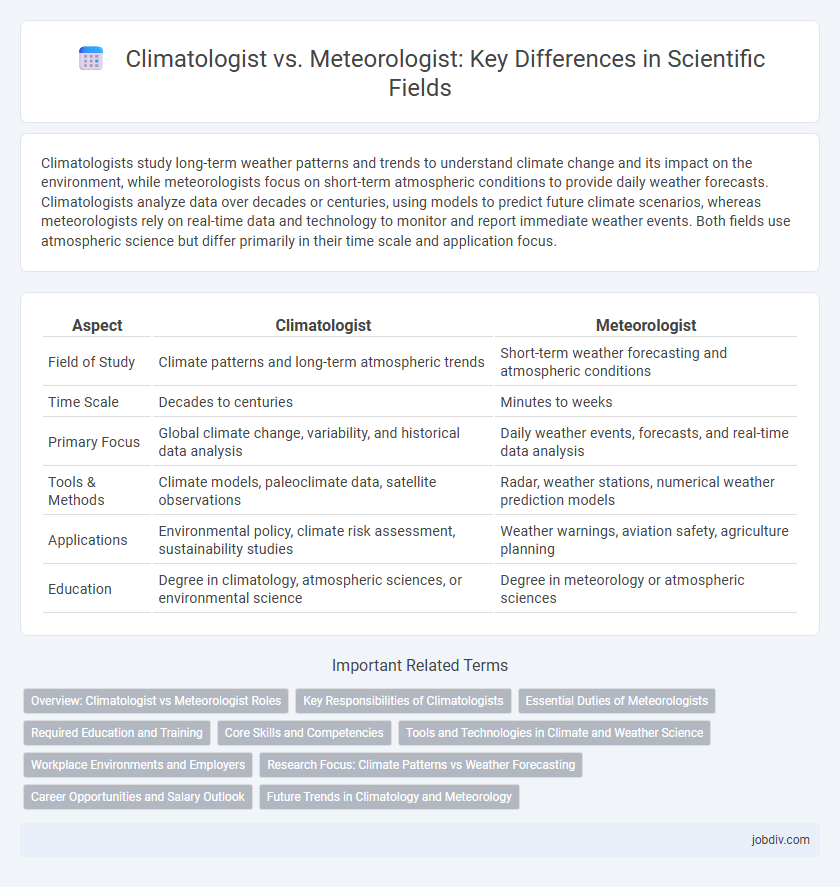Climatologists study long-term weather patterns and trends to understand climate change and its impact on the environment, while meteorologists focus on short-term atmospheric conditions to provide daily weather forecasts. Climatologists analyze data over decades or centuries, using models to predict future climate scenarios, whereas meteorologists rely on real-time data and technology to monitor and report immediate weather events. Both fields use atmospheric science but differ primarily in their time scale and application focus.
Table of Comparison
| Aspect | Climatologist | Meteorologist |
|---|---|---|
| Field of Study | Climate patterns and long-term atmospheric trends | Short-term weather forecasting and atmospheric conditions |
| Time Scale | Decades to centuries | Minutes to weeks |
| Primary Focus | Global climate change, variability, and historical data analysis | Daily weather events, forecasts, and real-time data analysis |
| Tools & Methods | Climate models, paleoclimate data, satellite observations | Radar, weather stations, numerical weather prediction models |
| Applications | Environmental policy, climate risk assessment, sustainability studies | Weather warnings, aviation safety, agriculture planning |
| Education | Degree in climatology, atmospheric sciences, or environmental science | Degree in meteorology or atmospheric sciences |
Overview: Climatologist vs Meteorologist Roles
Climatologists analyze long-term atmospheric data to understand climate patterns and predict changes affecting ecosystems and global weather trends, focusing on decades to centuries. Meteorologists study short-term weather phenomena, providing daily forecasts and severe weather warnings by examining atmospheric conditions over hours to weeks. Both roles utilize advanced modeling and data analytics but differ primarily in temporal scope and application in environmental planning and public safety.
Key Responsibilities of Climatologists
Climatologists analyze long-term weather patterns and climate data to understand trends and predict future climate changes. They conduct research on atmospheric phenomena, assess the impacts of climate change on ecosystems and human activities, and develop climate models using statistical and computational tools. Their work supports environmental policy making, natural resource management, and disaster risk reduction efforts.
Essential Duties of Meteorologists
Meteorologists analyze atmospheric data to forecast weather patterns, using tools such as radar, satellite imagery, and computer models. They monitor short-term weather changes to provide timely warnings for severe weather events, helping to protect life and property. Their essential duties also include communicating forecasts to the public and collaborating with emergency management agencies for disaster preparedness.
Required Education and Training
Climatologists typically require a master's or doctoral degree in climatology, meteorology, or environmental science, emphasizing advanced research skills and climate modeling. Meteorologists often hold a bachelor's degree in meteorology or atmospheric sciences, with hands-on training in weather forecasting and data analysis through internships or operational experience. Both professions necessitate strong proficiency in mathematics, physics, and computer science to analyze atmospheric data effectively.
Core Skills and Competencies
Climatologists specialize in analyzing long-term weather patterns using advanced data modeling and statistical analysis to understand climate change impacts, requiring expertise in atmospheric science, environmental science, and geographic information systems (GIS). Meteorologists focus on short-term weather forecasting and atmospheric phenomena through skills in data interpretation, real-time monitoring technologies, and communication to provide daily weather predictions. Both professions demand strong analytical abilities, knowledge of physics and mathematics, and proficiency with computer simulations and remote sensing tools to support accurate environmental assessments.
Tools and Technologies in Climate and Weather Science
Climatologists utilize advanced climate models, satellite data analysis, and long-term environmental monitoring tools to study atmospheric patterns and predict climate change over decades. Meteorologists rely on Doppler radar, weather satellites, and real-time data from weather stations to forecast short-term weather events and atmospheric conditions. Both fields increasingly incorporate machine learning algorithms and high-performance computing to enhance predictive accuracy and data interpretation in climate and weather science.
Workplace Environments and Employers
Climatologists predominantly conduct research in academic institutions, government agencies such as NOAA, and environmental consulting firms, focusing on long-term climate patterns and data analysis in laboratory and office settings. Meteorologists frequently work in meteorological offices, television stations, and emergency management centers, where they analyze weather data and provide forecasts in high-pressure environments. Both professions may collaborate with universities, government bodies, and private companies, but climatologists emphasize research, while meteorologists prioritize real-time weather prediction and public communication.
Research Focus: Climate Patterns vs Weather Forecasting
Climatologists analyze long-term climate patterns and trends, studying data over decades to understand changes in the Earth's climate system, including global warming and atmospheric cycles. Meteorologists concentrate on short-term weather forecasting, using atmospheric data and models to predict daily and weekly weather conditions such as temperature, precipitation, and storm movement. Both fields utilize advanced meteorological instruments and computational models but differ primarily in their temporal scale and research focus.
Career Opportunities and Salary Outlook
Climatologists typically engage in long-term climate pattern research, leading to career opportunities in environmental consulting, government agencies, and academia with median salaries around $80,000 annually. Meteorologists focus on short-term weather forecasting, offering roles in broadcast media, aviation, and emergency management, where median wages average approximately $95,000 per year. Both professions benefit from strong STEM backgrounds, but meteorologists often experience higher demand due to immediate weather-related needs.
Future Trends in Climatology and Meteorology
Future trends in climatology emphasize advanced climate modeling and AI-driven data analysis to predict long-term environmental changes with greater precision. Meteorologists are increasingly integrating real-time satellite technology and high-resolution forecasting models to improve short-term weather predictions and disaster preparedness. Collaborative efforts between climatologists and meteorologists leverage big data and machine learning to enhance the understanding of atmospheric dynamics and climate resilience strategies.
Climatologist vs Meteorologist Infographic

 jobdiv.com
jobdiv.com